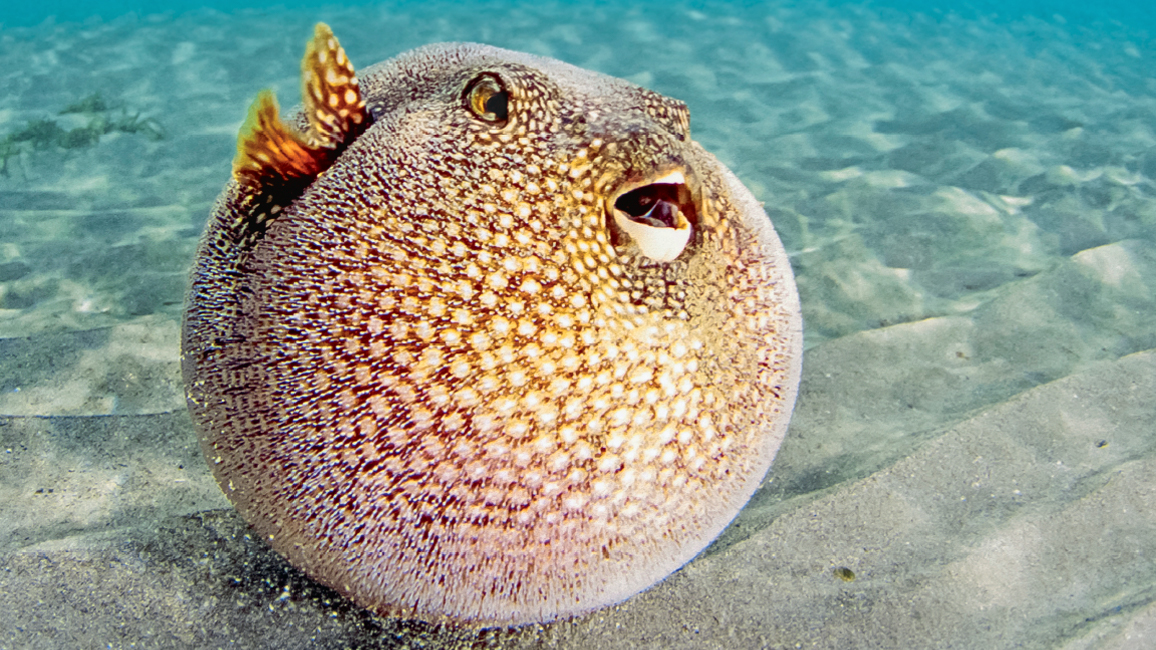
Fishy Puffer-Uppers
By Kathy KrankingWhen in doubt, puff it out! A pufferfish knows what to do when danger may be near.
Sometimes, when people are feeling afraid, they might suck in a big mouthful of air. Gulp!
When a pufferfish is nervous or afraid, it gulps mouthfuls of water. It gulps and gulps—up to 35 times! As the fish swallows all that water, its skin stretches and its body swells up. Soon it looks like a water balloon with fins! Finally, having grown two or three times its normal size, the puffer is more than a mouthful for most enemies. What a “swell” trick!
Later, once the pufferfish feels safe again, it blows out the water and returns to its normal shape.
VIDEO: WATCH A PUFFERFISH UNPUFF
THAT’S ME!
The pufferfish at left has puffed up to protect itself. When danger passes, it unpuffs again.
WATCH OUT!
The porcupinefish (above) is a kind of pufferfish that’s covered with long, sharp spines. The spines lie flat until the fish puffs up. Then it becomes a puffy pincushion!
PUFFER BASICS
There are about 210 species of pufferfish. Most live in warm ocean waters, but some live in fresh water. The smallest pufferfish grow to be only about the size of your thumb. The largest can be longer than your arm.
Pufferfish eat a lot of different things, including plant-like algae (AL-jee) and tiny animals. Big pufferfish will eat crabs, clams, and other crunchy food. Pufferfish have sharp beaks that they use to scrape algae off coral or to crack open shellfish.
BUILT TO PUFF
Pufferfish aren’t very fast. They can’t always outswim predators. So puffing up is a great way for them to stay safe. The secret to how it works lies inside a puffer’s body. Its stomach is lined with folds of skin that are like the folds of an accordion. As the fish gulps in water, the folds open and the stomach gets bigger and bigger. The puffer’s outer skin is very elastic and stretches at the same time, until the puffer has puffed into a big, hard ball.
PLAN B
Sometimes an enemy may manage to catch a pufferfish before it inflates. In that case, some puffers have a backup escape plan: bad-tasting poison in their skin and other parts of their bodies. This poison may be enough to make an enemy spit the puffer back out. If it doesn’t, the puffer may be the enemy’s last meal. A few predators, though, such as tiger sharks and sea snakes, are not bothered by the poison of a puffer.
The puffer above is feasting on a sea star. It has a sharp beak it uses to tear up its food.
A puffer usually puffs up with water but can also gulp air. After this one got plucked out of the water by a heron, it gulped air to puff up. Maybe the heron was left thinking, “Now what?”
MATING GAME
When it comes to puffers making more puffers, different species do different things. All females lay eggs. But some species of puffers care for their eggs in a nest, while others just release their eggs to float around freely until the baby puffers hatch.
A few years ago, scientists discovered a new kind of pufferfish. At the same time, they solved a mystery. For years, divers had seen strange round patterns on the sea floor. They couldn’t imagine what had made them. Then they caught the “artist” in the act. It was a male pufferfish of the new species—building a nest!
To make the nest, the pufferfish swims along the sea floor, flapping his fins to move the sand into a pattern. The fish is only about five inches long, but he makes circles wide enough for a very tall adult to lie across!
If a female puffer likes the nest a male has made, she will lay her eggs in the middle of the circle. Scientists aren’t sure why a female may like or dislike a certain nest. Only the pufferfish know for sure!
FUGU, PLEASE
In Japan, some people like to eat the raw flesh of pufferfish—a dish they call fugu (FOO-goo). But there’s a catch to this meal: Many parts of the fish are poisonous. It must be carefully prepared by master chefs who study for years to learn how. Sometimes, though, people buy and try to prepare fugu themselves—a dangerous idea. The poison in one pufferfish could kill 30 people!
The pattern above is a nest made by a male pufferfish. He even decorated it with shells. When a female decides she likes the nest, the two become mates.
“Fishy Puffer-Uppers” originally appeared in the September 2016 issue of Ranger Rick magazine.
(Click on each image above for a closer view of the story.)



















